Rumor has it that Bitcoin Punks have increased a hundredfold? A detailed explanation of the current state of Bitcoin network NFT projects and infrastructure
Written by: Misty Sea, PANews
Recently, the minting of NFTs on the Bitcoin network has continuously appeared in the public eye, with the community's attitude evolving from initial indifference to partial understanding and then to active participation. According to Dune's data panel, there are currently 33,517 NFT collectibles minted on the Bitcoin network, with 12,102 NFTs minted in a single day on February 9.
Among them, the NFT project Bitcoin Punks, based on the Bitcoin mainnet Ordinals protocol, completed its minting at 3 PM on February 9, totaling 10,000 pieces. The official Bitcoin Punks team is currently completing the collection, analysis of existing inscriptions, and verification of the first upload node for each Punk. The final JSON mapping of the 10,000 collectible set will be written into the Ordinals protocol within the next 24 hours.
According to official information, Bitcoin Punks is the first project to successfully upload the original Ethereum CryptoPunks to the Bitcoin blockchain using Ordinals. The team stated that to create this website, they are checking the hash values of each image uploaded to Ordinals and comparing them with the original 10,000 Punk images. The link pointing to Bitcoin Punks is the first inscription (with the lowest ID), which contains the corresponding hash value on the Ordinals protocol.
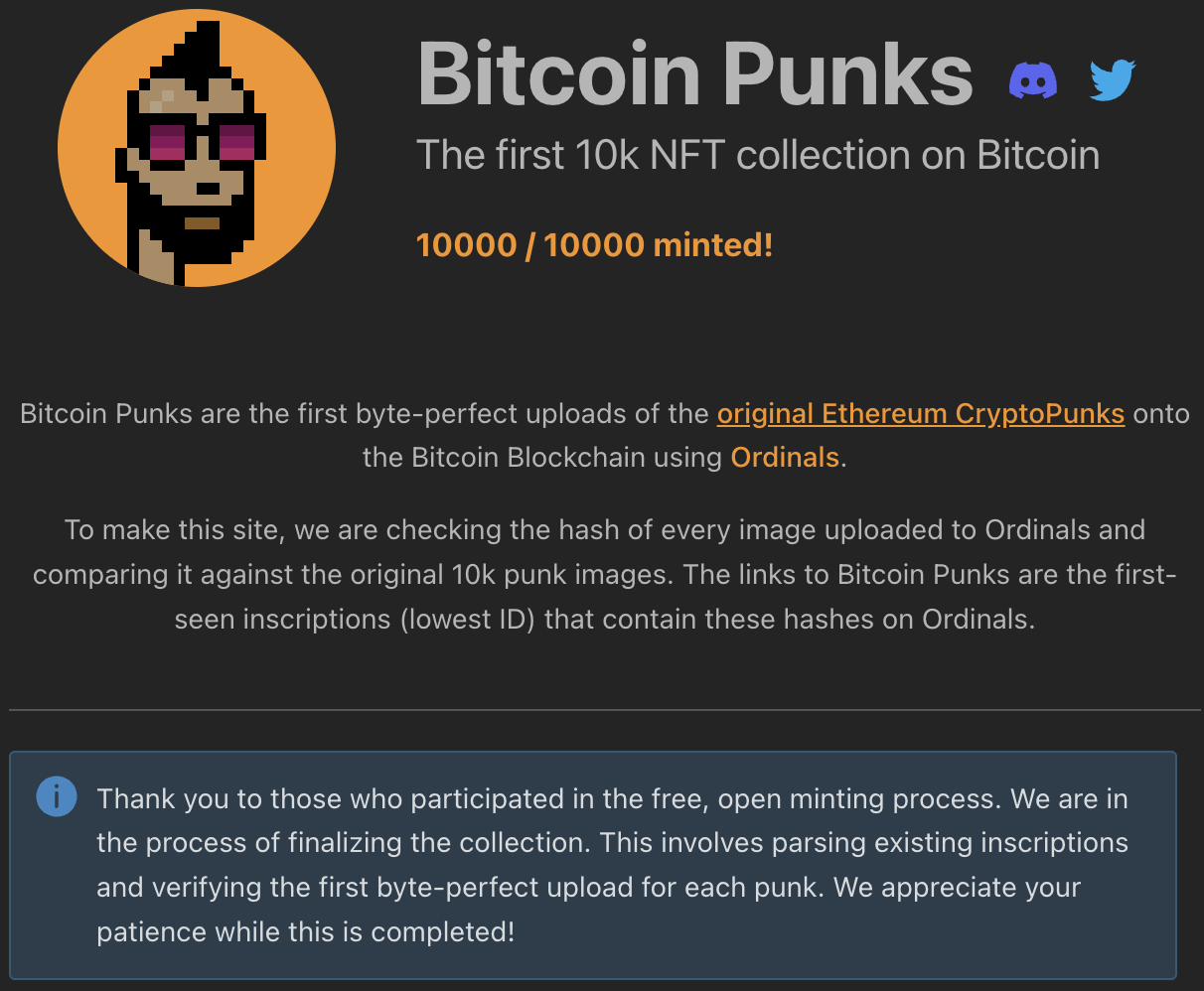
The specific steps for minting Bitcoin Punks are as follows: download the Sparrow wallet, then create a Native Segwit (P2WPKH) wallet, and create a Taproot (P2TR) wallet to receive Bitcoin Punks collectibles. Next, go to the Bitcoin Punks official website to find unminted Punk numbers, and then download the corresponding Punk images from cryptopunks.app. Finally, go to the Ordinals protocol full node Bot official website to upload the images downloaded in the previous step, using the created Native Segwit (P2WPKH) wallet to pay Bitcoin to the full node Bot, and receive the collectibles with the Taproot (P2TR) wallet. Payment methods include the Lightning Network and regular Bitcoin network transfers, with the Lightning Network generally being faster.
The minting cost for Bitcoin Punks is approximately $25, and there is currently no over-the-counter (OTC) trading. Additionally, during the minting process, because Bitcoin payments are made in a single order format and the Bitcoin network payment speed is relatively slow, multiple users on the network who do not communicate with each other can successfully pay for the same Punk number, but ultimately only the user whose block is confirmed first can obtain the Punk. This has led to many users paying Bot fees but ultimately not receiving the Punk collectibles.
According to information from Twitter KOLs, after the minting of Bitcoin Punks was completed, the secondary market price reached over 1 Bitcoin, which is a hundred times higher than the cost price. However, according to PANews' observations in the community, there have been no transactions for Bitcoin Punks, meaning there is no buyer's market, and the hundredfold increase is a rumor. Community members need to carefully discern information and avoid being misled into losses.
How is the development of NFTs on the Bitcoin network?
On January 21, 2023, software engineer Casey Rodarmor released version 0.4.0 of the Bitcoin network NFT protocol Ordinals, officially bringing NFTs to the Bitcoin mainnet. This protocol essentially supports Bitcoin versions of NFTs, which are described on the Bitcoin network as "digital artifacts," and can include image formats like JPEG, PDF, video, and audio. Since the launch of the Ordinals protocol, there have been continuous NFT projects issued and minted, and data from Dune shows that Ordinals NFTs have rapidly increased since February, with the vast majority being image content.
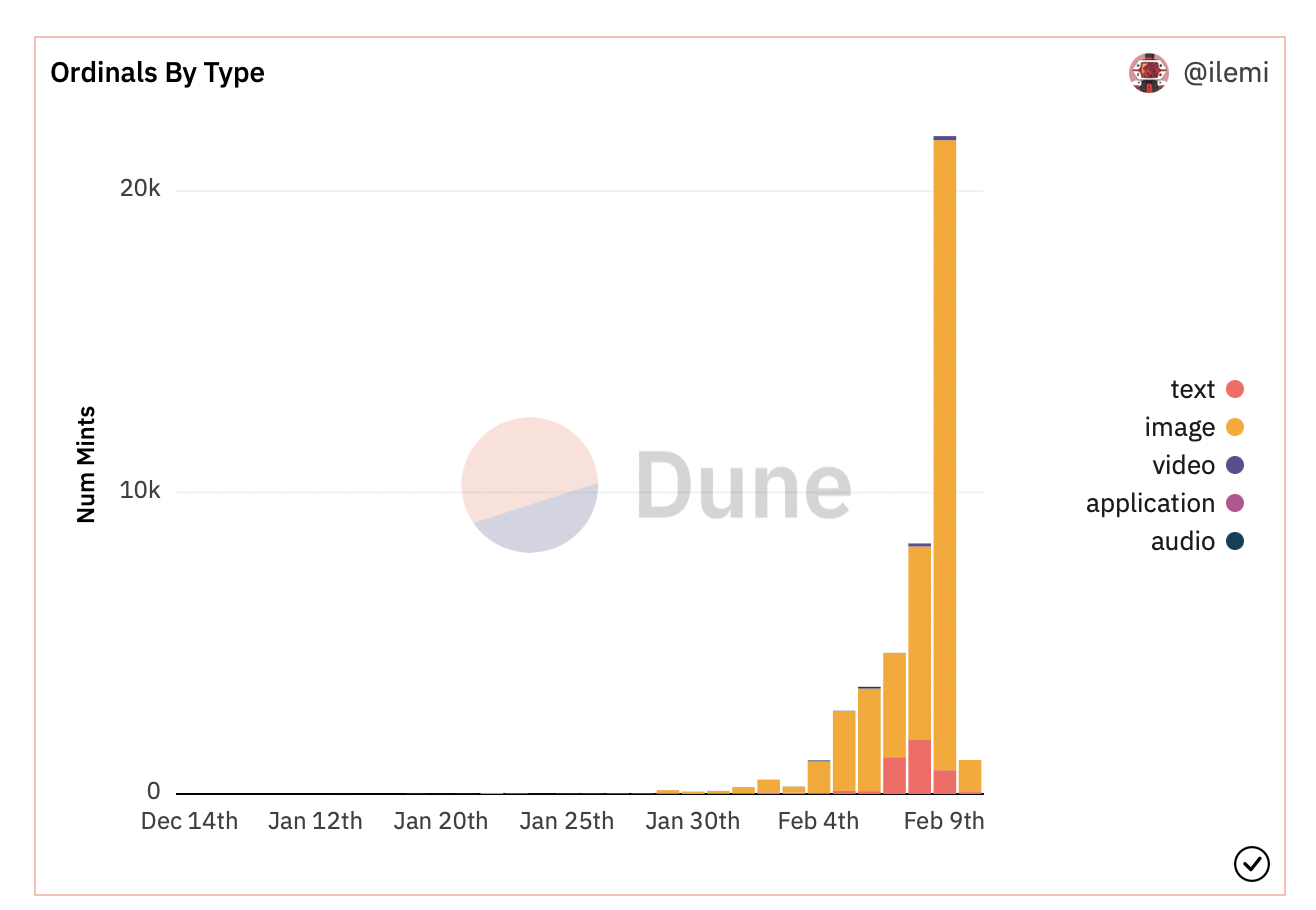
Bitcoin Rock
The Bitcoin Rock collectible has a total issuance of 100 pieces and is the first NFT project on the Bitcoin network issued based on the Ordinals protocol. The CEO of the NFT project Forgotten Runes Wizard's Cult, dotta, purchased one Rock for 0.2 Bitcoin on February 1. According to official Twitter information, its current transaction price has risen to 1 Bitcoin. Additionally, the team has donated 10 BTC to members of the Ordinals team to thank and support their work.
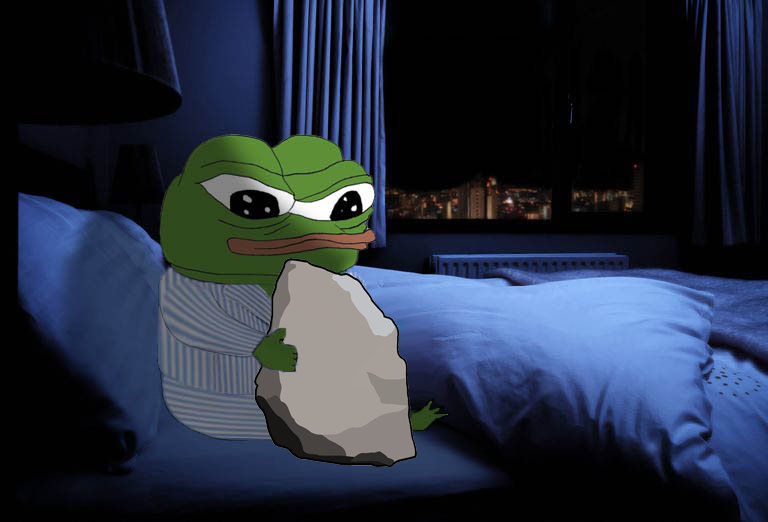
Ordinal Punks
Ordinal Punks are PFP collectibles minted among the first 650 inscriptions on Bitcoin, with a total issuance of 100 pieces. According to individuals associated with the project, Ordinal Punks "use open-source algorithms and CC0 Punk sprites to generate new Punks." The official Ordinal Punks team posted their first tweet on January 31, and minting began at 4 AM on February 1, completing in one day with a minting price of 0.01 Bitcoin. According to the bot Ordinal Punk Sales on Twitter, the first transaction price for Ordinal Punks was 0.07 Bitcoin, with the current highest transaction price reaching 9.5 Bitcoin, valued at $241,000. The total number of transactions has exceeded 30.
A well-known user in the NFT community, dingaling, purchased 7 Ordinal Punks collectibles, including Punk 27 (inscription #444), Punk 48 (ins #483), Punk 73 (ins #599), Punk 80 (ins #606), Punk 88 (ins #614), Punk 91 (ins #617), and Punk 92 (ins #618) for 15.2 Bitcoin (equivalent to 211 Ethereum) on February 9, stating that there are real moments behind each inscription number.
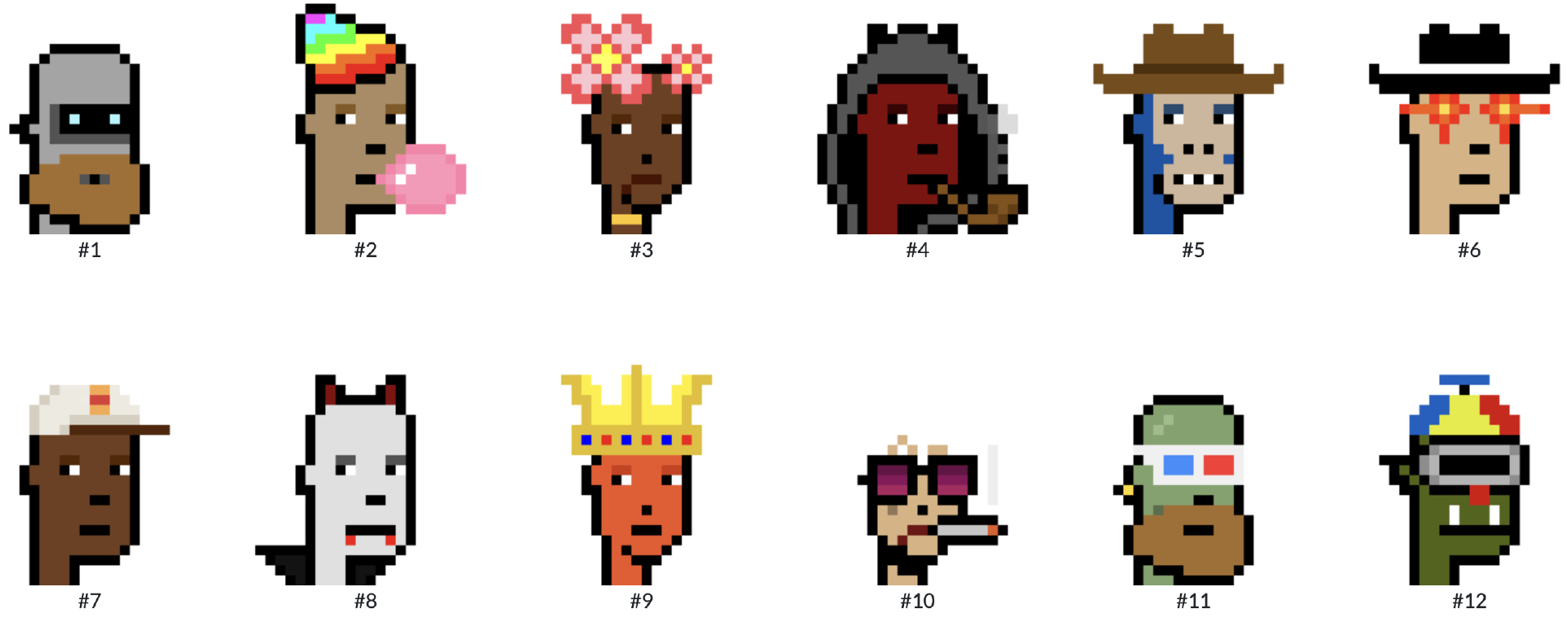
Additionally, there are projects like Bitcoin's first ordinal collectible, Bitcoin Shrooms, which claims to be the last bastion of human digital art before the upcoming artificial intelligence, and Shadow Hats, all of which have established official Twitter accounts and built official websites but have not yet started minting.
Moreover, the NFT project On the Edge of Oblivion, which is issued on the Ethereum network, promises to cross-chain to the Bitcoin network, with inscription order based on the holder's ERC-721 collectible ID, has risen from 0 to 2.4 ETH, with a total issuance of 555 pieces and a current transaction volume of 1,000 ETH. This reflects the current FOMO sentiment towards NFT projects on the Bitcoin network.
Infrastructure status of NFTs on the Bitcoin network
The foundational setup related to NFTs on the Bitcoin network is currently in its early stages. Minting is not as convenient and simple as on the Ethereum network; users need to learn to create different types of wallets, distinguish between different payment methods, and synchronize with the Bitcoin network full node to participate in minting NFTs based on the Ordinals protocol. There are also no convenient and secure peer-to-peer trading tools like Opensea; instead, a shared spreadsheet is used to update the order book, and sales can only be completed through over-the-counter trading or escrow. This inevitably involves deceptive practices.
Bitcoin Punks was able to be minted quickly thanks to the full node Bot developed by community members. If an individual completes the synchronization of the full node, it takes a long time and cannot be done overnight. The image below shows a community member synchronizing the Bitcoin network full node. However, currently, due to the order number mode of minting, users cannot know whether a particular ordinal has been successfully added to the chain, leading to situations where users are charged fees even if the minting fails when using the full node Bot, creating a barrier for some users.
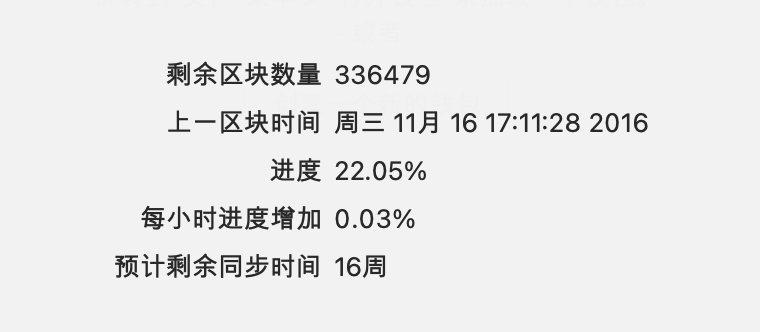
After the launch of the Ordinals protocol, the average daily block size of Bitcoin reached 2,021,079.56, a new high in three years. On February 7, Pierre Rochard, Vice President of Research at Bitcoin mining company Riot Platforms, tweeted that the Bitcoin network NFT protocol Ordinals' inscriptions are consuming 50% of Bitcoin's block space, with a block space utilization rate of 100%, and the median fee rate has decreased.
Therefore, there are differing opinions within the Bitcoin community regarding the issuance of NFTs based on the Ordinals protocol on the Bitcoin network. Some believe it will provide more financial use cases for Bitcoin, driving demand for block space and thus increasing fees. For instance, Bitcoin educator Dan Held believes that as the block reward decreases, miners will increasingly rely on transaction fees. If Ordinals indeed intensifies competition for block space, higher transaction fees may encourage miners to continue securing the Bitcoin network.
On the other hand, some believe it deviates from Satoshi Nakamoto's vision of Bitcoin as a peer-to-peer cash system, and that these NFT-like structures have already occupied block space on the Bitcoin network, which may drive up transaction fees. In 2010, Satoshi Nakamoto rejected the idea of expanding the Bitcoin system, stating, "It is not scalable to pile every proof-of-work arbitration system in the world into one dataset." Related reading: 《++Interpretation of the Controversy over the Ordinals Protocol: Is it Feasible to Issue NFTs on the Bitcoin Blockchain?++》
In this regard, PANews believes that many users entering the blockchain and Web3 are not doing so because of Bitcoin, and thus know little about the Bitcoin system. A large number of users have never used a Bitcoin wallet, never made a Bitcoin transfer, and do not know what Bitcoin full nodes or the Lightning Network are. Whether it is the Nostr social protocol or the launch of the Ordinals protocol, both increase the application scenarios on the Bitcoin network, guiding more users to begin to understand and recognize the Bitcoin ecosystem, thus encouraging more users to start using Bitcoin. Therefore, the open development of the Bitcoin network and multi-faceted attempts are not a bad thing. As for how it develops and whether it is good or bad, it is determined by the market's free competition and judgment.
Regarding the infrastructure related to NFTs on the Bitcoin network, as wealth effects and user numbers increase, competition among ecological products will gradually build and improve. What we can do now is to allocate more attention to the development of the Bitcoin network ecosystem. At the same time, it is important to note that the current NFT projects on the Bitcoin network are in a chaotic state, with many nascent projects, making it a process of sifting through sand for gold. Users need to conduct thorough due diligence while seeking business opportunities to avoid asset losses.










